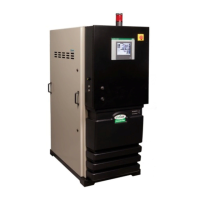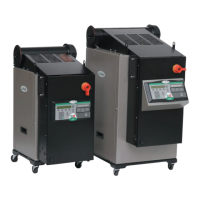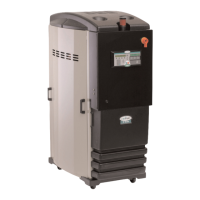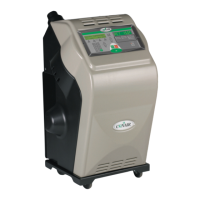6-16 l Trou ble sh oo ti ng
Problem
Hopper Loader Conveying
Demand (Self-loading
Option) - The demand sensor
located at the material receiver
has not been satisfied after
three attempts.
Conveying Blower Overload
– The conveying blower over-
load has tripped due to a
mechanical or electrical
problem.
NOTE: Once the over-
load has tripped, you
must wait 2 - 15
minutes with power on
for it to reset automati-
cally.
Possible cause
The sensor is not adjusted properly.
No material is being conveyed.
The conveying load time is too short.
Conveying blower is not coming on.
The conveying filter is clogged.
Hoses have come off or are loose in
the conveying loop.
The air operated valves are not open-
ing.
The conveying blower has mechanical-
ly failed or is unable to rotate freely.
The conveying blower has failed elec-
trically.
The overload is set incorrectly.
Solution
Adjust the sensor as needed.
Check the material supply.
Increase the load time setpoint.
Check the blower fuses in the control
and the overload settings.
Clean or replace the conveying filter.
Check for loose hoses and make sure
all hose clamps are secure.
Make sure compressed air is con-
nected and that the solenoid valves
are operating properly.
Disconnect and lock out main
power. Check the conveying blower
for mechanical failure and free rota-
tion. Replace if necessary. Allow
overload to reset, then try to restart
the conveying blower.
Disconnect and lock out main
power. Check the conveying blower
for electrical shorts or open circuits.
Replace if necessary. Allow over-
load to reset, then try to restart the
conveying blower.
Disconnect and lock out main
power. Check the overload settings
and confirm that the settings match
the full load amps listed on the con-
veying blower motor. Allow over-
load to reset, then try to restart the
conveying blower.
(continued)
✐
Passive Alarms
If the amber Acknowledge Alarm LED is blinking, the alarm is a passive alarm.
The dryer continues to operate, but this problem could prevent correct drying of
your material. Note that when the Acknowledge Alarm button is pressed once, the
blinking amber LED becomes solid.
NOTE: Passive alarms can be configured as shutdown alarms (see the previous Shutdown Alarms
section). See page 4-26, screen 62 for instructions.
✐
